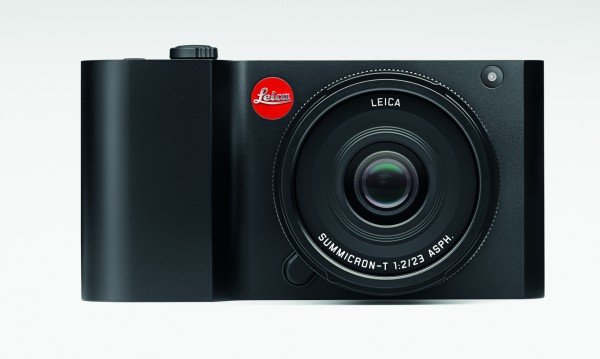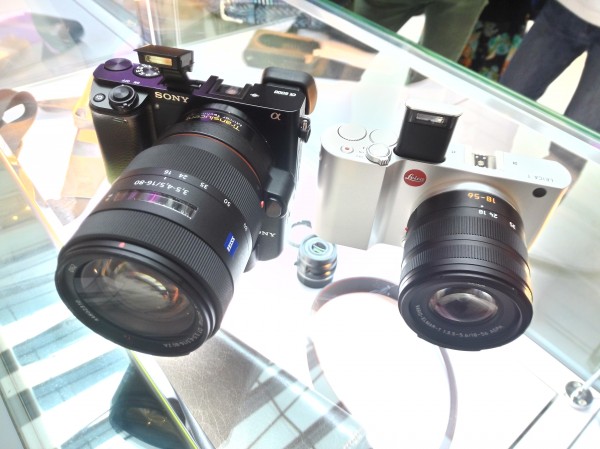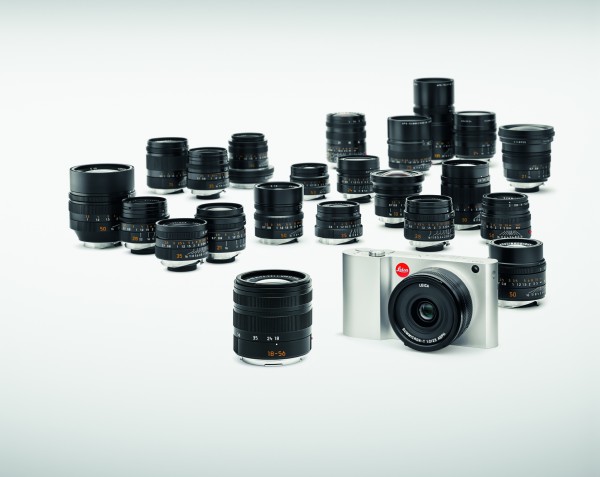
Full metal designs seem to be the in-thing of late with smartphones such as the HTC One and Asus Padfone Infinity, and now, the trend is coming to cameras with Leica’s new T model out in Singapore.
Carved from a solid block of aluminium, the Leica T certainly felt “weighty” when I had it in my hands at a launch event here this week. This lent a sense of luxury to the premium camera, while still being light enough not to be a burden for an avid shooter.
The T is a beautiful camera, make no mistake. It is impossible not to be awed by its clean lines and smooth surface. The components such as the flash hot-shoe and screen are flushed with the surface of the camera, completing the image of a well-crafted machine.
Side by side with the Sony NEX A6000 with adapted Alpha DSLR lens. Size wise, they are pretty similar.
When it comes to controls, the Leica T reminds me of the Sony NEX 7 mirrorless camera with the same two control wheels on the top plate. However, Leica has implemented its own unique control mechanism using the 3.7-inch LCD touch screen.
During my brief hands-on, it took me quite a while to get up to speed, especially for someone who is used to a mode dial. Still, I expect the controls to grow on me positively after spending some time with it.
The two control wheels on the top plate remind me of the Sony NEX 7 Mirrorless camera.
As the camera sports a 4,928 x 3,264 or 16-megapixel APS-C size sensor, it requires a new line of T lenses. At launch, you have the Leica Vario-Elmar-T 18-56mm f3.5-5.6 “kit” lens and the Summicron-T 23mm f2 lens. Another two more lenses, a wide angle and a telephoto zoom, will appear at Photokina show in September this year.
With only four lenses available for the Leica T this year, the concern among potential buyers is understandable. However, the “kit” zoom lens and the street-friendly Summicro-T 23mm f2 are more than enough to cover most shooting demands.
What’s curious to me is the Leica T’s use of an APS-C sensor – Leica is known for its image quality, after all. According to Maike Harberts, product manager for the Leica T-System, the use of the cropped sensor is borne out of the need to balance image quality with the needs of customers who are not professional photographers.
That would mean the provision of an auto focusing system for its lens and the lack of a viewfinder on the body to keep the camera body small. There is an option to purchase a plug-in electronic viewfinder if you want it bad enough.
To make things more consumer-friendly, the Leica T also comes with Wi-Fi connectivity to share pictures instantly online. Plus, it allows direct control of the camera via a smartphone app.
Do take note though if you own previous Leica lenses. The excellent M-mount lenses would require you to use an adapter to fix onto the Leica T.
An unlike Leica’s M series cameras with its split prism viewfinder, the Leica T only allows on-screen zoom of x3 and x6 magnification to ensure correct manual focusing. A focus peaking feature, as seen on most mirrorless cameras, would be a great help here.
As expected from the German company, pictures that are produced by the Leica T are well saturated and skin tones are very close to natural, going by some quick test shots I had at the launch.
What I’d look out for is the Summarit-M lens. Used on the Leica T, it should bring a higher level of sharpness, resulting in the legendary “Leica pop” that the German company is famous for.
The Leica T won’t be cheap, as you’d expect from a premium camera. It will go for S$4,950, with a Leica Vario-Elmar-T kit lens. One of course could get them individually with the body going for S$2,550, the Leica Vario-Elmar-T Kit lens for S$2,400 and the Summicron-T 23mm f/1 lens at S$2,700. The Leica T system will hit the stores on 26 May 2014.
We’ll have more details on the Leica T when we test the camera more thoroughly in the weeks ahead.

![Leica T - Black [9]](https://www.techgoondu.com/wp-content/uploads/2014/04/Leica-T-Black-9-600x279.jpg)




